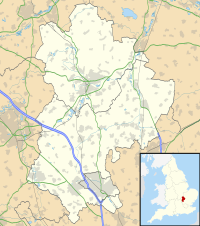Higham Gobion Castle facts for kids
Quick facts for kids Higham Gobion Castle |
|
|---|---|
| Higham Gobion, Bedfordshire, England | |
| Coordinates | 51°59′12″N 0°23′29″W / 51.9868°N 0.3914°W |
| Type | Castle |
| Site information | |
| Condition | Earthworks |
Higham Gobion Castle was an old castle from the 11th century. It was found in the small village of Higham Gobion. Today, this area is part of Shillington in the English county of Bedfordshire.
Contents
What Was Higham Gobion Castle?
Higham Gobion Castle was a special type of fortress. It was made mostly of timber, which is wood. This kind of castle is called a motte and bailey castle.
What is a Motte and Bailey Castle?
A motte and bailey castle has two main parts. The "motte" is a big, raised earth mound. A wooden tower or fort would sit on top of this mound. The "bailey" is a large, enclosed area next to the motte. This area was usually surrounded by a fence or wall, and it held buildings like houses and stables.
Who Built the Castle?
The Gobion family built this castle. The castle and the nearby town got their name from this family. They built it sometime after the Norman Invasion of 1066. This was when William the Conqueror took over England.
Where Was It Built?
The castle was built in a marshy, wet area. It covered a large, triangle-shaped space. The small motte, or earth mound, was inside this triangle. Strong ramparts helped protect the site. Ramparts are like big earth walls or banks that make it hard for enemies to attack.
The castle was not alone in the area. It was about 3 miles from Pirton Castle. It was also 14 miles south of Bedford Castle.
What Remains Today?
Today, you cannot see the castle buildings anymore. Only the earthworks are left at the site. Earthworks are the shapes and mounds in the ground that show where old buildings once stood. They are like clues from the past.
Interestingly, people have found old Roman items near the castle site. These include coins, parts of a millstone, and cinerary urns. Cinerary urns are pots used to hold ashes after someone has been cremated. These finds show that people lived in this area a very long time ago, even before the castle was built!


